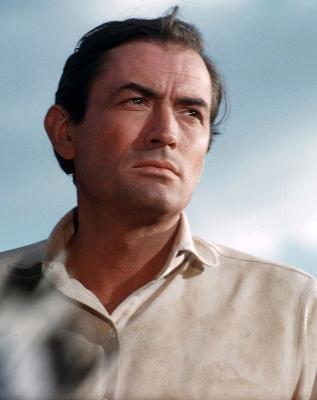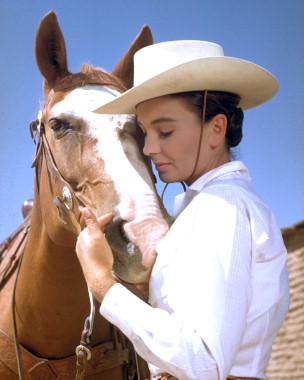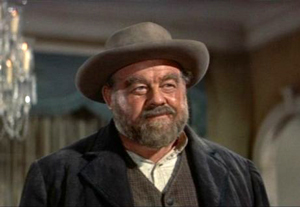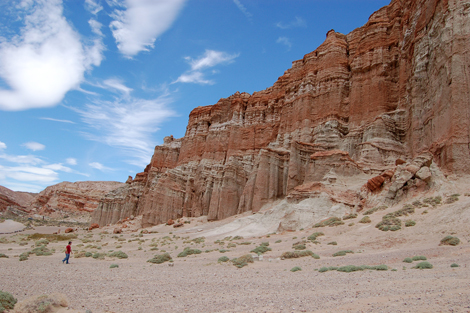
 |
|
|
|
Americans love their epic westerns and The Big Country gives them yet another variation on the 'big ranch dynasty' theme that worked its way through a number of films, only to end up squeezed onto the small screen with TV's Bonanza. As an examination of power and hubris in the American West, we received epic ranch dynasty sagas based on sex (Duel in the Sun), manifest destiny (Red River), rampaging greed (The Furies), the sins of the fathers (The Man from Laramie), civil rights (Giant), womanly power (40 Guns) and conservative values (Chisum). This particular western subgenre demonstrates how 'adult' westerns tended to reflect contemporary political issues. 
The Big Country's source novel is by Donald Hamilton, a pulp scribe who cleaned up with his series of Matt Helm thrillers, later made into a number of Dean Martin movies. Co-producers William Wyler and Gregory Peck apparently agreed on the idea of making their super-western comment indirectly on the big issue of their day, the Cold War nuclear standoff. To this end they hired author Jessamyn West to adapt the first screenplay. Ms. West wrote Wyler's previous picture, the sublime Friendly Persuasion. A pacifist message hovers over this exciting and pleasing western adventure. When the range is free the film soars, especially with Jerome Moross's spectacular music setting the tone. But The Big Country still seems a bit constrained by that durn Easterner pacifist civilization moralizing. We're told that the highly civilized producing partners Peck and Wyler fought like cats and dogs on the set, but I don't know whether the trouble was over star prerogatives or creative differences. The strife can't be seen in the final product, leaving Mr. Peck's reputation as a Hollywood nice guy intact. We're told that Wyler formed a solid bond with special supporting star Charlton Heston, a development that led to a rather important acting assignment for Mr. Heston. The Big Country's West is a nearly treeless expanse that becomes a battleground for feuding pioneer families, despite the fact that said landscape doesn't look fit for growing or raising anything. Led by the obstinate Rufus (Burl Ives), the rough-hewn Hannasseys, live in shacks and barely get by. Rufus' son Buck (Chuck Connors) is an irresponsible thug. The aristocratic Terrills have grown rich off their land and live in a Southern-style mansion. The proud Major Henry Terrill (Charles Bickford) behaves like landed gentry, and thinks that the Hannaseys are scum that need to be wiped out. The Major's spirited, immature daughter Pat (Carroll Baker) is engaged to James McKay (Gregory Peck), a sea captain who wants to retire to the ranching life. But both father and daughter are upset with McKay's refusal to approve their blind aggression toward the Hannasseys. It's assumed that because he won't fight, McKay is a coward. The ranch ramrod Steve Leech (Charlton Heston), who is also in love with Pat, is quick to brand Jim as yellow. Seeing how shallow Pat's affections really are, McKay drifts toward the more sensible Julie Maragon (Jean Simmons), Pat's best friend and the town schoolteacher. As it so happens, Julie owns a key strip of land that would give the water-parched Hannassey cattle access to a local stream called The Big Muddy. Rufus Hannassey gets the notion that if Buck were to marry Julie Maragon, he'd be able to finally checkmate The Major's attempts to wipe the Hannasseys off the map. 
As Major Terrill's party guests keeps repeating, "It's a big country", but apparently not big enough for the two warring families. Before one can say Peaceful Coexistence a bitter conflict is established. Directors Robert Aldrich and Anthony Man would quickly accelerate the action to the level of gunplay, but it takes roughly two hours for this story to heat up. We mostly see various gang intimidation rituals. Buck Hannassey and his scurvy cowpokes haze the Easterner McKay during a buggy ride. The boorish Buck Hannassey gives Julie Maragon grief on the bird-brained illusion that she can stand to be in the same room with him (Papa Rufus does suggest that Buck take a bath once in a while.) The Terrills' reactions are always disproportionate. The Major's men publicly beat and whip Buck's friends right in town. Ignoring Jim McKay's calls for reason, The Major then drives the Hannassey cattle away from water, a move that even the hard-bitten Steve Leech must admit is going too far. The Big Country mostly lacks big set pieces, which is not necessarily a bad thing. A half-hour in, when some riders set out to make trouble, the action still remains bloodless. With the range war mostly covered in dialogue, the up- front romantic and dramatic issues take precedence. Wyler's superior direction makes all of the relationships seem vital and alive. We can tell from the start which girl should win the noble Jim McKay. Rufus Hannassey responds to The Major's provocations with an almost Biblical challenge, right at Pat and Jim's engagement party. Rufus tosses a shotgun at The Major's feet, should he want to settle their differences right then and there. Pat is a petulant airhead who doesn't see what kind of gem she has in Jim. She expects Jim to fit into her dream of staying home with daddy and having a handsome husband as well. Julie recognizes McKay's finer points and tries to bring Pat to her senses: "How many times does a man need to win you?" The Jim McKay - Steve Leech conflict is the best thing in the movie. The Western folk keep treating McKay, a season sailor, as if he were a schoolboy. I'd wager that an 1870s sea captain could very well have seen more of life and violence than any of these cow-punching clods. The Jim McKay character is a curiously perfect liberal invention, a paragon of fairness and diplomacy who should be back in Washington running for President. Gregory Peck's McKay as never raises his voice or imposes his opinion on anyone. And his previous fifteen years were presumably spent dishing out orders to surly crewmen on the high seas? McKay is disappointed that his future bride and father-in-law expect him to fight at the drop of an insult. When McKay sets out alone to see what the land looks like, the Terrells ignore his note and assume that he's a lost puppy, even though he can find his way around the world with his simple navigation tools. We enjoy the Jim McKay character despite his apparent perfection - he does everything but walk on water. Opposed to vigilante violence, he's a man with many cheeks to turn, a combination handsome hunk and Mohandas Gandhi. Yet the civilized gift he chooses for The Major is a set of formal dueling pistols, tokens of a yet older form of ritualized violence through which gentlemen settled their differences. Jim is perfectly willing fight when the stakes are important enough. But it seems odd that this pacifist movie should credit the false nobility of older forms of violent barbarism -- is it saying that Eisenhower and Krushchev should duke it out with six-guns, High Noon style? 
The movie's make or break key scene is McKay's pre-dawn fistfight with Leech, done without witnesses as a point of honor. If this scene was Jessamyn West's idea (I don't know), it both supports and destroys the thesis that fighting is an aspect of the human character that needs to be gotten rid of. By framing the fight in ever-widening angles, Wyler makes the combatants look like insignificant insects. It's an interesting, if obvious, point. But think of what has occurred: McKay breaks his own vow by fighting on Leeche's uncivilized terms. Yet he's gained something no mere talk could accomplish: although neither man will elaborate the point, Leech has come to respect and accept McKay. His loyalty to the unreasonable Major -- his foster father -- is broken. When do men respect each other? I'd say it's when they see another man taking risks for what he believes, putting something on the line. Had McKay given the Terrells a finely worded thesis against aggression, intimidation and murder of thy neighbor, they'd have dismissed him as a lily-livered Easterner. Or in the Cold War context of 1958, a Pinko. 1 William Wyler makes the film's rather simple relationships seem deep. Although not particularly attuned to genre filmmaking, Wyler is surely one of the best dramatic communicators among American directors. He can direct action but isn't particularly expressive with it; The Big Country barely has any, even though Wyler maintains the threat of violence throughout. 2 His crane-mounted camera swoops over buildings and holds deep focus to see riders appearing in the far background of dialogue scenes, etc. Just remember that for his epic like Ben-Hur, Wyler didn't have all that much to do with the giant action scenes with Roman galleys and racing chariots... he may have approved the plans but the second unit devil-dogs shot those scenes, which fairly closely replicate their corresponding sequences from the silent original. Wyler is much better blending menace and comedy, as when Julie & Jim swap gory stories at a crumbling ranch house, or when the cantankerous old Rufus beats his son Buck about the ears for behaving like such an idiot: "Did you even want me, Pa?" "I did before you were born." For all of its progressive posturing The Big Country is blindly retrograde in its disrespect for the Mexican-American ranch hand Ramón, played by Alfonso Bedoya as dim-witted comedy relief. I also wonder if one point of the Wyler-Peck confrontation was over McKay's scenes trying to ride "Old Thunder", the killer horse trotted out to haze foolish tourists. It seems a direct outgrowth of Gregory Peck's impressive horse-taming scene in Duel in the Sun twelve years earlier. In the first film, breaking the horse stood in for Lewt McCandless's "breaking" the hot-blooded Pearl Chavez. Here, the horse taming apparently represents the superiority of Jim's nonviolent attitude. Persistent patience tames a horse that the rugged Terrills could not. 
Although a lot of mostly cowpokes bite the dust or tumble down some pretty rugged cliffs (kudos to the stuntmen, there) The Big Country winds up with a symbolic victory of peacefulness over aggression. The moral magician McKay never pulls a trigger in anger, yet quite a few individuals that oppose his princely point of view end up plugged full of lead. Jim and Julie ride off to a happy future. Unfortunately, in that desolate outback, with all the interesting neighbors dead, it looks their future will be spent talking to those stinkin' cattle. We only hope that Steve Leech recovers and marries Pat. As the true Man of the West, Leech and McKay would be an unbeatable heroic combo. Now that's the movie we want to see. Everybody's good in The Big Country, even if Charles Bickford has to play such a stiff and Carroll Baker such a dodo. Burl Ives earned a supporting Oscar; he makes the entire range war plot function. But the real acting honors go Charlton Heston. He is spot-on in every line reading and character nuance and his character has a vital function in every dramatic conflict. Judging from his fine work with a number of top-grade directors, Heston really knew how to take direction from the great talents. MGM / Fox's Blu-ray of The Big Country is a stunning beauty. If you like westerns, by all means grab it quick. It was a Best Buy or Wal-Mart exclusive for a few weeks last summer but disappeared almost immediately. Savant makes a point of not directly pushing discs, but I happened to check the Amazon price on this one. As of this writing, The Big Country is a real steal. The picture looks so good that we wonder why transfers of other vintage movies run into so much trouble. This title has always looked drab on older video presentations, with desert landscapes that came off as brown mush. This HD release brings out their multi-colored beauty. 
I'll venture the guess that MGM reached back to original Technirama elements for this beautiful restoration. The Technirama process was essentially sideways-running VistaVision with a squeeze; this yielded sharp Technicolor prints at the 'scope aspect ratio. The film is therefore large format but not a 65mm show. I think the result looks marvelous. An earlier laserdisc isolated the entire Jerome Moross music score on a separate track. The music is a thing of beauty, an Aaron Copland-like whirl of exciting, stirring themes. Moross more or less adapted the same music for the later The Valley of Gwangi, of all things. The two scores are so similar, Ray Harryhausen fans unfamiliar with The Big Country may expect to see an Allosaurus leap into the frame. I could be wrong, but at MGM I was told that the sound mix on The Big Country was always monaural. Plans to release the original score in stereophonic sound were nixed for reasons unknown. Don't be deterred, as the movie's soundtrack as represented on this DTS-HD Master Audio track is really, really dynamic, clear and subtle. It's a terrific original mix. 4 MGM includes a good trailer (music-driven, naturally), a brief TV promo for ABC's Sunday Night at the Movies, and a featurette called Fun in the Country that has the general feel of a goofy educational short subject. We see Jean Simmons playing bridge, Burl Ives and Gregory Peck ("The intellectuals of the company") play chess, and a smiling Chuck Heston introduces Carroll Baker to a reluctant desert tortoise. That's followed by a couple of shots showing the cowboy actors (Chuck Roberson, prominently) holding a tortoise race. The whole thing is an exercise in innocuousness. (Innocuity? Innoculation?)
On a scale of Excellent, Good, Fair, and Poor,
The Big Country Blu-ray rates:
Footnotes:
1. I've read at least one essay that tried to assign a homosexual interpretation of the relationships in The Big Country, building on the usual observations of gunmen and their weapons, man with man rituals, etc. It's hogwash.
2. The best "action scene" in The Big Country occurs when a Hannassey tyke hauls off and kicks Charles Bickford's horse in the butt, HARD. "Wham!" That disciplined horse jumps a couple of inches but otherwise ignores the insult. I'd say that's the influence of Jessamyn West, as it seems a holdover of a Richard Eyer moment from Friendly Persuasion. 3. One of the film's beautiful locations is right off the highway up at Red Rock Canyon North of Edwards AFB in California. Anthony Mann used the same site for his Man of the West, released the same year. The film's 'big ride' toward the end takes place in front of an impressive cliff face, right next to the roadway. The company must have stopped traffic to allow the horse riders to 'round the bend and catch up with Charles Bickford's rigid Major. I've included a photo of the cliff face, above. 4. From correspondent Andrew A. Bendel, 11.22.11: Glenn, you are quite right when you wrote: "I could be wrong, but at MGM I was told that the sound mix on The Big Country was always monaural."
While most people (who claim to know about these things) seem to agree that the original orchestral recording sessions on Stage 7 at Goldwyn were recorded 3-track on fullcoat stock, the mix-down was monaural. I suppose the recording sessions might be still be stored away and theoretically could show up some day, but I'm not holding my breath. Even if they do, a stereo reissue would not be faithful to the original release soundtrack format. -Andy
Reviews on the Savant main site have additional credits information and are often updated and annotated with reader input and graphics. Also, don't forget the 2011 Savant Wish List. T'was Ever Thus.
Review Staff | About DVD Talk | Newsletter Subscribe | Join DVD Talk Forum |
| ||||||||||||||||||